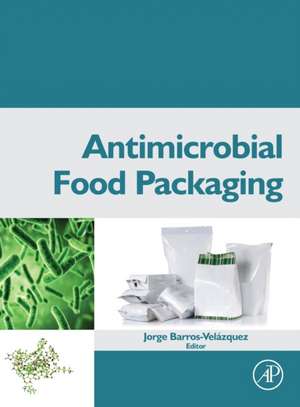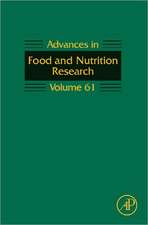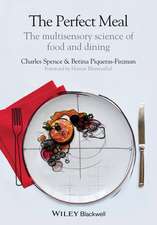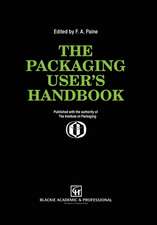Antimicrobial Food Packaging
Editat de Jorge Barros-Velazquezen Limba Engleză Hardback – 5 ian 2016
Tactics on the monitoring of microbial activity that use antimicrobial packaging detection of food borne pathogens, the use of biosensors, and testing antimicrobial susceptibility are also included, along with food safety and good manufacturing practices. The book aims to curtail the development of microbiological contamination of food through anti-microbial packaging to improve the safety in the food supply chain.
- Presents the science behind anti-microbial packaging and films reflecting advancements in chemistry, microbiology, and food science
- Includes the most up-to-date information on regulatory aspects, consumer acceptance, research trends, cost analysis, risk analysis and quality control
- Discusses the uses of natural and unnatural compounds for food safety and defense
Preț: 940.43 lei
Preț vechi: 1033.44 lei
-9% Nou
Puncte Express: 1411
Preț estimativ în valută:
179.94€ • 188.89$ • 149.36£
179.94€ • 188.89$ • 149.36£
Carte tipărită la comandă
Livrare economică 04-18 aprilie
Preluare comenzi: 021 569.72.76
Specificații
ISBN-13: 9780128007235
ISBN-10: 0128007230
Pagini: 676
Dimensiuni: 216 x 276 x 33 mm
Greutate: 2.06 kg
Editura: ELSEVIER SCIENCE
ISBN-10: 0128007230
Pagini: 676
Dimensiuni: 216 x 276 x 33 mm
Greutate: 2.06 kg
Editura: ELSEVIER SCIENCE
Public țintă
Professionals in food packaging, food technology, food safety, food scientists and technologists; microbiologists; chemistsCuprins
1: The Nature and Extent of Foodborne Disease2: Resistant and Emergent Pathogens in Food Products3: Bacterial Contamination in Food Production4: Fungal Contamination in Packaged Foods5: Viral Contamination of Food6: The Downside of Antimicrobial Packaging: Migration of Packaging Elements into Food7: Packaging Material in the Food Industry8: Effect of Packaging Systems on the Inactivation of Microbiological Agents9: Antimicrobial Susceptibility Testing of Foodborne Bacteria Related to National and International Resistance-Monitoring Programs10: Food Safety: Good Manufacturing Practices (GMP), Sanitation Standard Operating Procedures (SSOP), Hazard Analysis and Critical Control Point (HACCP)11: Control of Microbial Activity Using Antimicrobial Packaging12: Detection of Foodborne Pathogens Using Biosensors13: Detection of Foodborne Pathogens Using DNA Arrays14: Detection of Foodborne Pathogens Using Nanoparticles. Advantages and Trends15: Detection of Foodborne Pathogens Using MALDI-TOF Mass Spectrometry16: Industrial Applications: Regulatory Issues and Life Cycle Assessment of Food Packaging17: Antimicrobial Packaging for Meat Products18: Antimicrobial Packaging for Fresh and Minimally Processed Fruits and Vegetables19: Antimicrobial Packaging for Poultry20: Antimicrobial Packaging for Seafood21: Antimicrobial Packaging of Beverages22: Antimicrobial Active Packaging Systems Based on EVOH Copolymers23: Ethyl Lauroyl Arginate (LAE): Antimicrobial Activity and Applications in Food Systems24: Ethyl Lauroyl Arginate (LAE): Usage and Potential in Antimicrobial Packaging25: Volatile Compounds Usage in Active Packaging Systems26: Carvacrol-Based Films: Usage and Potential in Antimicrobial Packaging27: Gelatin-Based Nanocomposite Films: Potential Use in Antimicrobial Active Packaging28: Smart Nanohydrogels for Controlled Release of Food Preservatives29: Antimicrobial Food Packaging Based on Biodegradable Materials30: Pullulan: A Suitable Biopolymer for Antimicrobial Food Packaging Applications31: Use of Metal Nanoparticles for Active Packaging Applications32: Silver-Based Antibacterial and Virucide Biopolymers: Usage and Potential in Antimicrobial Packaging33: Antimicrobial Food Packaging Incorporated with Triclosan: Potential Uses and Restrictions34: Zinc Oxide Nanoparticles for Food Packaging Applications35: Antimicrobial Spices: Use in Antimicrobial Packaging36: Pediocin Applications in Antimicrobial Food Packaging Systems37: Casein and Chitosan Polymers: Use in Antimicrobial Packaging38: Multifunctional Films, Blends, and Nanocomposites Based on Chitosan: Use in Antimicrobial Packaging39: Cinnamaldehyde and Eugenol: Use in Antimicrobial Packaging40: Enzybiotics: Application in Food Packaging41: Zein and Its Composites and Blends with Natural Active Compounds: Development of Antimicrobial Films for Food Packaging: Casein-Based Zataria multiflora Boiss Films: Use in Antimicrobial Packaging43: Antimicrobial Peptides from Bacillus spp.: Use in Antimicrobial Packaging44: Chitosan-Oregano Essential Oil Blends Use as Antimicrobial Packaging Material45: Thymol: Use in Antimicrobial Packaging46: Organic Acids: Usage and Potential in Antimicrobial Packaging47: Combinational Approaches for Antimicrobial Packaging: Chitosan and Oregano Oil48: Combinational Approaches for Antimicrobial Packaging: Lysozyme and Lactoferrin49: Combinational Approaches for Antimicrobial Packaging: Natamycin and Nisin50: Combinational Approaches for Antimicrobial Packaging: Pectin and Cinnamon Leaf Oil51: Combinational Approaches for Antimicrobial Packaging: Bivalve Shell Waste-Derived Material and Silver52: Combinational Edible Antimicrobial Films and Coatings








